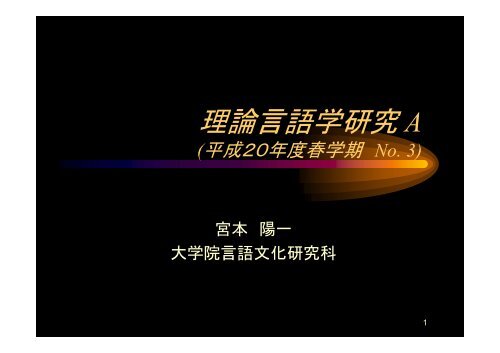to get the file
to get the file
to get the file
You also want an ePaper? Increase the reach of your titles
YUMPU automatically turns print PDFs into web optimized ePapers that Google loves.
理 論 言 語 学 研 究 A( 平 成 20 年 度 春 学 期 No. 3)宮 本 陽 一大 学 院 言 語 文 化 研 究 科1
Nature of TracesMove-αNP-Movement Trace: AnaphorWH-Movement Trace: ???2
WH-Trace = Anaphor? (1)• Do WH-traces obey Nominative Island Condition (NIC)?• NIC“A nominative anaphor in S cannot be free in S’ containingS.”(Chomsky 1980:13)• *Taro and Hanako 1 think that each o<strong>the</strong>r 1 bought it.• *Who 1 do you think that t 1 bought it?3
WH-Trace = Anaphor?(2)• Do WH-traces obey Specified Subject Condition (SSC)?• SSC“No rule can involve X, Y in <strong>the</strong> structure… X … [ α …Z …ーWYV …] …where Z is <strong>the</strong> specified subject of WYV in α.”(Chomsky 1973:239)• *Taro and Hanako 1 think that Akira saw each o<strong>the</strong>r 1 .• Who 1 do you think that Hanako saw t 1 ?4
However, Strong Crossover (SCO)• *He 1 thinks that Hanako likes Taro 1 .• *Who 1 does he 1 think that Hanako likes t 1 ?• WH-traces = R-expressions5
Unification (ECP)• NIC effects (but NOT SSC effects)• SCO effects• The Empty Category Principle (ECP)[See No.4 for its definition.]6
WH-Traces and Case (1)(1) Sa<strong>to</strong>shi 1 is certain [t 1 <strong>to</strong> buy <strong>the</strong> book].(2) Sa<strong>to</strong>shi 1 seems [t 1 <strong>to</strong> be <strong>the</strong> smartest].(3) *Who 1 is it certain [t 1 <strong>to</strong> buy <strong>the</strong> book]?(4) *Who 1 does it seem [t 1 <strong>to</strong> be <strong>the</strong> smartest]?• Generalization• WH-traces must have Case.7
WH-Traces and Case (2)• (1) Sa<strong>to</strong>shi is certain <strong>to</strong> buy <strong>the</strong> book.• (3) *Who is it certain <strong>to</strong> buy <strong>the</strong> book?• (✔) Who seems <strong>to</strong> be <strong>the</strong> smartest?• (✔’) [ S’ Who [ S t seems [ S t <strong>to</strong> be <strong>the</strong> smartest]]]Generalization• Every A-chain needs Case.8
ECP: Superiority Effects[ S’ [ S Who bought what]]• [ Who [ t bought what]]• *[ What did [ who buy t]]• Chomsky (1973): Conditions on Transformations9
Superiority Condition• COMP WH1WH2C-commandIf you (= WH1) asymmetrically c-commands WH2,<strong>the</strong>n you should move <strong>to</strong> COMP.See Chomsky (1973: 246) for <strong>the</strong> exact formulation of <strong>the</strong>Superiority Condition.10
Locative and Temporal WHs• Where did you put what?• What did you put where?• When did you buy what?• What did you buy when?*See Boskovic (1997) and Stroik (1996) for muchrelevant discussion.11
Pure Superiority Effects• Kuno and Robinson (1972)• Chomsky (1977)• Pesetsky (1982)• *△ △ WH1 WH212
That-Trace Effects• Who do you think [(*that) [ t saw Hanako]]?• Who do you think [(that) [ Hanako saw t]]?• [ S’ Who [ S do you think [ S’ t (*that)[ S t saw Hanako]]]]?*See Perlmutter (1971), Bresnan (1972), and Chomsky andLasnik (1977) for much relevant discussion.Important Q: How come Subjacency effects are absent here?14
Chomsky (1986)• Barriers = Subjacency + CED + ECP15



